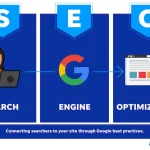
Search Engine Marketing Strategies: How SEM Works?
Understanding Search Engine Marketing (SEM)
Search Engine Marketing, often referred to as SEM, is a powerful digital marketing strategy or, Search Engine Marketing Strategies that aims to increase a website’s visibility in search engine results pages (SERPs) through paid advertising. This article delves into the fundamental aspects of SEM, explaining how it works, its key components, and its significance in the online business landscape.
Table of Contents:
- Introduction
- How Does SEM Work?
- Key Components of SEM
- 3.1 Keyword Research
- 3.2 Ad Auctions
- 3.3 Ad Quality and Relevance
- 3.4 Landing Pages
- Benefits of SEM
- Integrating SEM with Other Marketing Strategies
- Best Practices for Successful SEM
- Conclusion
- FAQs about SEM:
1. Introduction of digital marketing strategy:
In today’s highly competitive digital landscape, having a strong online presence is essential for businesses. Search Engine Marketing (SEM) plays a pivotal role in achieving this goal by utilizing paid advertising to promote a website on search engine platforms.
2. How Does SEM Work?
SEM operates on a pay-per-click (PPC) model, where advertisers bid on specific keywords relevant to their products or services. When users enter these keywords in search engines, the ads appear prominently in the sponsored sections of the SERPs. Advertisers only pay when their ads are clicked, making SEM a cost-effective method to drive targeted traffic.
3. Key Components of SEM:
3.1 Keyword Research:
Effective SEM begins with thorough keyword research. Identifying relevant keywords ensures that your ads are shown to users actively searching for products or services similar to what you offer.
3.2 Ad Auctions:
When a user initiates a search, an ad auction takes place. The search engine determines which ads to display based on factors like bid amount and ad quality.
3.3 Ad Quality and Relevance:
Search engines prioritize ads that are relevant to the user’s query. Crafting compelling ad copy with relevant keywords and a clear call-to-action enhances the ad’s quality score.
3.4 Landing Pages:
A well-optimized landing page is crucial for converting ad clicks into actual business. The landing page should align with the ad’s content, providing visitors with a seamless experience and encouraging them to take desired actions.
4. Benefits of SEM:
Search Engine Marketing offers several benefits for businesses:
- Immediate Visibility: SEM provides instant visibility on search engine results pages, driving immediate traffic to your website.
- Targeted Reach: Advertisers can target specific demographics, locations, and devices, ensuring their ads reach the right audience.
- Measurable Results: SEM platforms offer detailed performance metrics, allowing advertisers to track their campaigns’ effectiveness.
- Cost Control: With a pay-per-click model, advertisers only pay when users click on their ads, optimizing budget allocation.
- Complementing SEO: SEM can work in synergy with Search Engine Optimization (SEO) efforts to enhance overall online presence.
5. Integrating SEM with Other Marketing Strategies:
SEM can complement other marketing strategies like Search Engine Optimization (SEO) and social media marketing. Integrating these efforts can lead to a holistic digital marketing approach. how to make money online
6. Best Practices for Successful SEM:
- Keyword Selection: Choose relevant keywords with moderate to high search volume.
- Compelling Ad Copy: Craft engaging ad content that resonates with the target audience.
- A/B Testing: Continuously test different ads and landing pages to optimize for better results.
- Conversion Optimization: Ensure that your landing pages are designed for conversions.
7. Conclusion:
Search Engine Marketing is a dynamic and results-driven approach that empowers businesses to enhance their online presence and connect with their desired audience. By understanding its core components and implementing best practices, businesses can leverage SEM to achieve their marketing goals effectively.
In conclusion, Search Engine Marketing (SEM) is a vital tool for businesses striving to succeed in the digital realm. By strategically placing ads in front of users actively searching for related products or services, SEM offers a unique opportunity to drive targeted traffic and achieve measurable results. As technology and online consumer behavior continue to evolve, mastering SEM remains an essential skill for businesses looking to thrive in the competitive online landscape.
FAQs about SEM:
- Q: Is SEM the same as SEO?
A: No, SEM and SEO are distinct strategies. SEM involves paid advertising to appear in search results, while SEO focuses on optimizing your website’s content and structure to improve organic (unpaid) rankings.
- Q: How much does SEM cost?
A: The cost of SEM varies based on factors like keyword competitiveness and budget. You set your bid amount, and you’re charged each time a user clicks on your ad.
- Q: Can I target a specific audience with SEM?
A: Yes, SEM platforms allow precise audience targeting based on factors like location, demographics, interests, and device type.
- Q: What is a Quality Score?
A: Quality Score is a metric used by search engines to assess the relevance and quality of your ads and landing pages. Higher Quality Scores can lead to better ad placements and lower costs.
- Q: Are there alternatives to Google Ads for SEM?
A: Yes, Bing Ads is a popular alternative to Google Ads. It operates similarly and allows you to reach a different user base.
- Q: How quickly will I see results from my SEM campaign?
A: SEM can yield immediate results, as your ads start showing once your campaign is approved. However, optimizing for better performance may take time.
For more information or do you have any relevant questions feel free to Click Here






